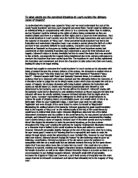It could be argued that the most interesting characters In Shakespeare's plays King Lear, there are many interesting characters however the action in the play is driven by the villainous characters. This is often the case in Shakespeare’s plays, but it may be even more so in this play, which contains four villainous characters. There are King Lear's two daughters, Regan and Goneril, who turn on their father as soon as they have enjoyed a taste of his power. There is Regan’s husband, Cornwall, who engages in the most physically gruesome act of evil behavior ever exhibited in any Shakespeare’s work when he gouges out Gloucester's eyes. Finally, there is Edmund, who is arguably the most interesting character in the entire play and who easily takes on the role of the most villainous character in the play.
Goneril is the first of the King Lear's daughters to express to him the depths of her love. She tells him that, “Sir I love you more than word can wield the matter” (1.1.60). However, we soon realize that Goneril is not the loving daughter she presents herself to her father as in the first scene of the play. She tells Regan that something must be done quickly to make sure that their father does not “carry authority with such disposition as he bears” (1.1.351-352) to act as rashly with her and Regan as he did with Kent and Cordelia. When Regan suggests that they think on it further, Goneril responds, “We must do something i’ th’ heat of times” (1.1.355). When Lear comes to stay with Goneril, it does not take long for her to act against her father. Goneril insults her father saying “As you are old and reverend, should be wise. Here do you keep a hundred knights and squires, men so disordered, so debauched and bold, that this our court, infected with their manners, shows like a riotous inn” (1.4.247-251). Her actions and words makes Lear decide to take a long journey to stay with Regan. Later in the play, when Goneril falls in love with Edmund, her villainy clearly shifts. Her actions change from that of a cold hard bitch to that of a jealous teenage girl. She sees Edmund as a future lover and her anger against her father quickly materializes into anger against both her husband, Albany, and her sister as they are seen as objects in her way against a relationship with Edmund. In the heat of passion, she takes a further step toward outright evil by committing murder when she poisons her own sister.

This is a preview of the whole essay
Teacher Reviews
Here's what a teacher thought of this essay
This essay shows the dangers of taking a descriptive and narrative approach. The writer mostly describes the villains, and tells us what they did, illustrating these points with appropriate quotation. This is all done clearly and accurately, but very little argument or analysis is offered. This analysis could be achieved by comparing the villains with the virtuous characters, and attempting an explanation of the appeal of the villains. And surely an argument needs to be put forward as to why we might find the villains more interesting than Lear? **







